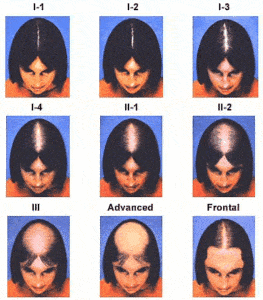Many women experience different forms of hair loss at some point in their lives, especially after pregnancy, during times of stress or as a side effect of certain medications. According to Clinical Interventions on Aging, less than 45% of women will maintain a full head of hair throughout their lifetime. Additionally, any medication or therapy that alters a woman’s hormonal activity, such as contraceptives, can trigger hair loss.
Extensive and long-term hair loss is described by the generic medical term alopecia. The most common types of female hair loss are androgenetic alopecia, telogen effluvium, anagen effluvium and traction alopecia. While there are various causes of female hair loss, the most common is androgenetic alopecia or female pattern hair loss.

Androgenetic alopecia (AGA) or “female pattern” hair loss is a type of hair loss manifested by diffuse thinning on all areas of the scalp. AGA results from male hormones that are typically present in small amounts in women called androgens. The male hormone dihydrotestosterone (DHT) causes certain hair follicles on the scalp to become shorter and shorter, eventually disappearing. Although heredity is involved in AGA, hormone activity can also play a role. Major instances causing hormone shifts such as pregnancy, menopause, ovarian cysts and taking birth control pills with a high androgen index can be linked to this form of hair loss.
Similar to male pattern hair loss, both heredity and hormones seem to play major roles in female pattern hair loss. However, patterns of hair loss appear differently in women than in men. Whereas male pattern hair loss typically concentrates at the front of the hairline and at the crown of the head, women with androgenetic alopecia more often have diffuse thinning on all areas of the scalp.
Once the cause of the hair loss is determined, the next step in figuring out the best course of treatment is to evaluate the extent of the hair loss. Several scales measure the extent of female hair loss, but the two most common standards are the Ludwig Scale and the Savin Scale. The two are almost identical, except the Savin Scale measures overall thinning as well as the density in the hair, shown by the hair pictured at the crown.

Stages I-1, I-2, I-3, I-4: illustrate the female crown hair density. The first stage (I-1) shows a woman with a central part in her hair with no hair loss. The part widens in images I-2, I-3, and I-4, demonstrating thinning hair along the top of the scalp and the crown area.
Stages II-1, II-2: show increasingly thin hair at the top of the scalp as the hair loss advances.
Stage III: represents a woman with severe female pattern hair loss, concentrated at the top of the head and crown area.
Advanced: while rarely seen in clinical practice, this picture shows a very advanced stage of female pattern hair loss, with almost no hair remaining on the crown or top of the head.
Frontal: demonstrates female pattern hair loss concentrated more at the forehead area than the crown of the head and gradually moves back. This pattern is fairly rare among women who experience hair loss.
The good news is that hair replacement solutions are available for nearly every stage of hair loss. To learn about the various options that may be a fit for you, contact Complete Image Clinic for a completely confidential consultation.
Telogen Effluvium (TE)
Telogen effluvium (TE) is another type of hair loss in women, typically catalyzed when the body goes through a traumatic event such as major surgery, childbirth or suffers from malnutrition. Experience of trauma can cause hair follicles to transition from the “rest” phase (telogen) to a shedding phase resulting in hair loss. At any given time, a healthy scalp has 10% – 20% of the hair follicles in the resting phase. Other stressors include certain types of medication or environmental exposures. There are also chronic forms of TE in women.
To treat TE, the cause must first be discovered. If the cause is an event or trauma, hair growth can resume normally within a few months once the body and mind have had a chance to recover. However if the hair loss remains or the cause cannot be identified, a direct hair growth stimulator may be employed to block TE from redeveloping.
Anagen Effluvium
Anagen effluvium is a form of hair loss that occurs when something inhibits the hair follicle’s metabolic activity. Commonly associated with chemotherapy, this type of effluvium hair loss affects hairs in the active or anagen phase. Once chemotherapy has begun, 90% or more of the hairs can fall out while in this anagen phase. A tapered hair shaft characterizes anagen effluvium, fracturing as it narrows and resulting in hair loss.
Various hair replacement systems, including wigs and wiglets, can be attractive and effective solutions for women experiencing this type of hair loss.
Traction Alopecia
Traction alopecia is caused by hairstyles inflicting trauma on the hair follicles. Tight hairstyles such as cornrows, braiding, extensions and strained ponytails/buns are the most common styles that produce traction alopecia.
Typically hair will regrow if the condition is detected early, though hair replacement systems are options for women who experience this type of hair loss and the hair does not regenerate.
